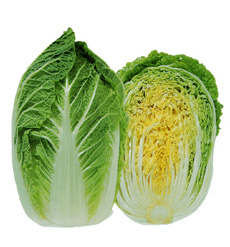TIP OF THE DAY: Try Some Napa Cabbage In Your Recipes
|
In the course of our New Year’s resolution to eat a low-calorie, fiber-packed salad twice a day, we’ve been scouring produce departments for variety.
As an alternative to red cabbage, we’ve been buying napa cabbage, originally from China and a common ingredient in Chinese recipes. Even if you don’t like cabbage, try it: Napa cabbage has a mild, sweet flavor—a cross between cabbage, iceberg lettuce and celery (it’s sometimes called “celery cabbage”). The leaves are very crisp and are equally enjoyable raw or cooked. In the fridge, keep the cabbage in a different compartment from ethylene-producing fruits such as apples and bananas, which will speed up the deterioration. Otherwise, a head can last for a week or more. |
 Whole and half heads of napa cabbage. |
|
|
THINGS TO MAKE WITH NAPA CABBAGE Napa cabbage originated in the region of Beijing, China. Both napa cabbage (Brassica rapa, subspecies pekinensis), which grows in a head, and bok choy (Brassica rapa, subspecies chinensis), which grows in leaf-topped stalks (think celery), are referred to as “Chinese cabbage.” For clarity, avoid using that term. Both are related to the Western cabbage, Brassica oleracea, and are part of the cancer-fighting cruciferous family, Brassicaceae, that also includes broccoli, cauliflower, horseradish, mustard, radish, rapeseed and others. Why is a Chinese vegetable called “napa,” which sounds like it comes from California’s Napa Valley? The word derives from nappa, a colloquial Japanese term that refers to the leaves of any vegetable. In Japan, what we call napa cabbage is called hakusai. |
||


